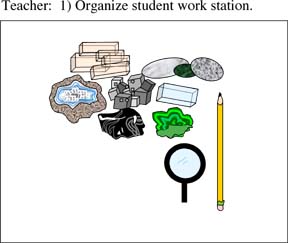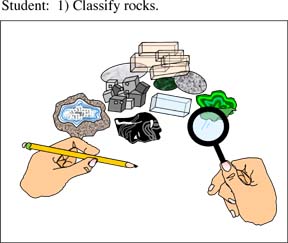 |
 |
|
|
|
|
4th Grade Performance Task 1992-93 Administration Description: Students study and observe rocks and identify properties that can be used to classify or divide the rocks into groups. Students then identify other properties that could be used to classify or divide other objects into groups. This task is designed to take students approximately 45 minutes to complete. Overall Task Content Area:
Specific Knowledge Areas:
Performance Expectations:
4 A SI 1: Ability to do scientific inquiry: Grades K-4
4 B PS 1: Properties of objects and materials: Grades
K-4 4 D ESS 1: Properties of Earth materials: Grades K-4
(Use the "hot" link on the PALS home page to check the full text of related National Science Education Standards, if desired.) National Council of Teachers of Mathematics:AL1: Understand patterns, relations and functions:Grades pre K-5 a. sort, classify, and order objects by size, number, and other properties. DAP1: Formulate questions that can
be addressed with data and collect, organize, and display relevant
data to answer them: GEO1: Analyze characteristics and properties of two-
and three-dimensional shapes and develop mathematical arguments
about geometric relationships: MEAS2: Apply appropriate techniques, tools, and formulas
to determine measurements: PS3: Apply and adapt a variety of appropriate strategies
to solve problems: RP3: Develop and evaluate mathematical arguments and
proofs: CON1: Recognize and use connections among mathematical
ideas: REP1: Create and use representations to organize, record,
and communicate mathematical ideas: General Instructions to the Teacher: This task is designed to take students approximately 40-50 minutes to complete. Students will be working in groups of 4 - 6 for the experiment/activity part of this exercise. Students work together for up to 20 minutes. They are instructed to notify you when finished with the group work, and then to go on to the individual work beginning with question #1. If students are still working together 20 minutes after the testing begins, instruct them to cease their group work and begin individual work. At this point, they may no longer talk. Whether or not they are just beginning their individual work, remind students that they now have about 25 minutes to complete the individual activity. Students should be ready to work as soon as the period begins. Group assignments should be made in advance. The materials should be set out at each lab station, if possible. A central supply area, if needed, should be easily accessible. All supplies should be clearly labeled. Materials for "Classifying Rocks": At this station students should have:
Advance Preparation: None required. Safety:
Extensions/modifications:
Advanced Preparation Set Up:
|

